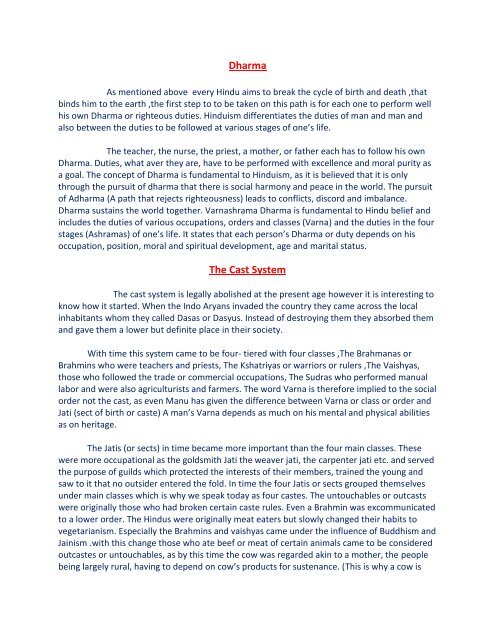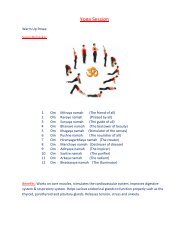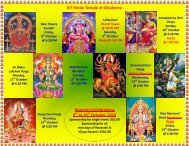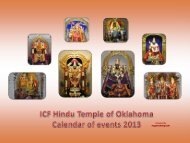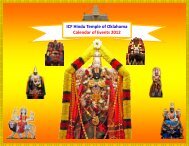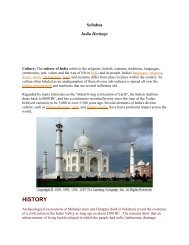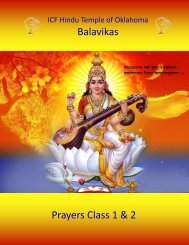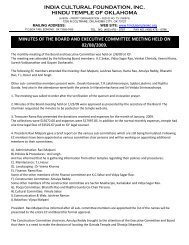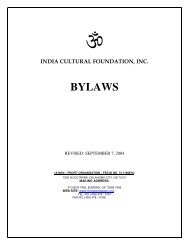Balavikas - Hindu Temple of Oklahoma City
Balavikas - Hindu Temple of Oklahoma City
Balavikas - Hindu Temple of Oklahoma City
Create successful ePaper yourself
Turn your PDF publications into a flip-book with our unique Google optimized e-Paper software.
Dharma<br />
As mentioned above every <strong>Hindu</strong> aims to break the cycle <strong>of</strong> birth and death ,that<br />
binds him to the earth ,the first step to to be taken on this path is for each one to perform well<br />
his own Dharma or righteous duties. <strong>Hindu</strong>ism differentiates the duties <strong>of</strong> man and man and<br />
also between the duties to be followed at various stages <strong>of</strong> one’s life.<br />
The teacher, the nurse, the priest, a mother, or father each has to follow his own<br />
Dharma. Duties, what aver they are, have to be performed with excellence and moral purity as<br />
a goal. The concept <strong>of</strong> Dharma is fundamental to <strong>Hindu</strong>ism, as it is believed that it is only<br />
through the pursuit <strong>of</strong> dharma that there is social harmony and peace in the world. The pursuit<br />
<strong>of</strong> Adharma (A path that rejects righteousness) leads to conflicts, discord and imbalance.<br />
Dharma sustains the world together. Varnashrama Dharma is fundamental to <strong>Hindu</strong> belief and<br />
includes the duties <strong>of</strong> various occupations, orders and classes (Varna) and the duties in the four<br />
stages (Ashramas) <strong>of</strong> one’s life. It states that each person’s Dharma or duty depends on his<br />
occupation, position, moral and spiritual development, age and marital status.<br />
The Cast System<br />
The cast system is legally abolished at the present age however it is interesting to<br />
know how it started. When the Indo Aryans invaded the country they came across the local<br />
inhabitants whom they called Dasas or Dasyus. Instead <strong>of</strong> destroying them they absorbed them<br />
and gave them a lower but definite place in their society.<br />
With time this system came to be four- tiered with four classes ,The Brahmanas or<br />
Brahmins who were teachers and priests, The Kshatriyas or warriors or rulers ,The Vaishyas,<br />
those who followed the trade or commercial occupations, The Sudras who performed manual<br />
labor and were also agriculturists and farmers. The word Varna is therefore implied to the social<br />
order not the cast, as even Manu has given the difference between Varna or class or order and<br />
Jati (sect <strong>of</strong> birth or caste) A man’s Varna depends as much on his mental and physical abilities<br />
as on heritage.<br />
The Jatis (or sects) in time became more important than the four main classes. These<br />
were more occupational as the goldsmith Jati the weaver jati, the carpenter jati etc. and served<br />
the purpose <strong>of</strong> guilds which protected the interests <strong>of</strong> their members, trained the young and<br />
saw to it that no outsider entered the fold. In time the four Jatis or sects grouped themselves<br />
under main classes which is why we speak today as four castes. The untouchables or outcasts<br />
were originally those who had broken certain caste rules. Even a Brahmin was excommunicated<br />
to a lower order. The <strong>Hindu</strong>s were originally meat eaters but slowly changed their habits to<br />
vegetarianism. Especially the Brahmins and vaishyas came under the influence <strong>of</strong> Buddhism and<br />
Jainism .with this change those who ate beef or meat <strong>of</strong> certain animals came to be considered<br />
outcastes or untouchables, as by this time the cow was regarded akin to a mother, the people<br />
being largely rural, having to depend on cow’s products for sustenance. (This is why a cow is


